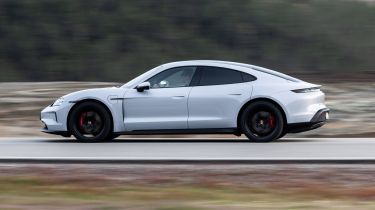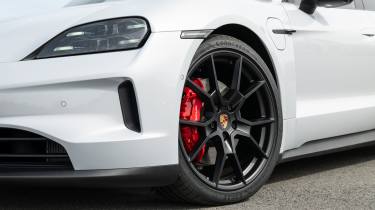Porsche Taycan: performance, motor & drive
The Porsche Taycan is extraordinarily fast by any measure, but its handling finesse is what makes it a milestone car
| Model | 0-62mph | Top speed | Driven wheels | Power |
| Taycan (97kWh) | 4.8s | 143mph | Rear | 429bhp |
| Taycan 4S (82.3Wh) | 3.7s | 155mph | Four | 536bhp |
| Taycan Turbo (97kWh) | 2.7s | 162mph | Four | 872bhp |
| Taycan Turbo S (97kWh) | 2.4s | 162mph | Four | 939bhp |
| Taycan Turbo GT (97kWh) | 2.3s | 180mph | Four | 1,020bhp |
If you’re concerned as to what will happen to performance cars when all models go electric, take a short drive in the Porsche Taycan and your fears will swiftly be quashed.
With mind-bending acceleration and true Porsche sports car handling, the Taycan is amongst the fastest and most dynamic EVs out there and represents a momentous technological achievement by the German brand. It gets better, too, as the facelifted model improves things even further.
Porsche Taycan 0-62mph, top speed and acceleration
Every Taycan received a power boost as part of the 2024 facelift, which means there’s even more of a punch whenever you plant your right foot. Even the entry-level 402bhp rear-wheel drive model will launch from 0-62mph in a mere 4.8 seconds. Moving up to the 590bhp dual-motor 4S reduces this time to 3.7 seconds, while the 872bhp Turbo almost defies air-resistance with a sprint time of just 2.7 seconds.
Still not quick enough? The 939bhp Taycan Turbo S will hit 62mph in 2.4 seconds. Or, if you fancy troubling Tesla Model S Plaid owners, the full-fat 1,020bhp Taycan GT will shave off another tenth of a second. Whichever Taycan you choose, it won’t be lacking when it comes to acceleration.
Top speed starts at 143mph for the entry-level Taycan, and this figure climbs all the way up to 190mph for the Taycan Turbo GT.
The best part, though, is that the Taycan’s thundering performance is still straightforward to manage. The rate of acceleration isn’t overly harsh, and it takes a great deal to upset the car’s traction. This makes the Taycan exciting to drive, rather than unnerving.
Unusually for an electric car, the Taycan's rear motor uses a two-speed transmission (most make do with a single ‘gear’) in order to offer the best combination of performance from a standstill and efficiency at motorway speeds. The shift between the two is imperceptible; it's a really smooth car to drive – that is, unless you’re as tempted as we were to just floor the accelerator and enjoy the Taycan’s seemingly never-ending power.
Porsche claims the variable regenerative braking is powerful enough to do 90% of driving without touching the brake pedal at all, however we found that even the strongest of the two available settings wasn’t quite enough to slow the car sufficiently around town. It bleeds in smoothly and makes the Taycan easy to drive fluidly through awkward traffic, but we’d still favour steering-wheel paddles for more intuitive adjustment.
Handling
The Taycan weighs over two tonnes, but you’d never guess that based on how it drives: agile and responsive in corners, with a playful and communicative feel that belies its mass. Note that a lot of items that affect how the car drives are optional on lower-end models; we’d add the active anti-roll bars and four-wheel steering for best results. With all that fitted, the Taycan truly sets a new benchmark in terms of handling delight for electric cars; lightfooted yet confidence-inspiring and characterful, it's totally satisfying on the right road, despite its size.
You might think a low-riding sports saloon like the Taycan would make sacrifices when it comes to ride comfort, but this isn’t the case; all but the cheapest Taycan get adaptive air suspension which helps iron out the biggest lumps and bumps. Don’t get us wrong, a Mercedes EQS will still trump the Porsche with its cloud-like wafting, but the Taycan should be more than comfortable enough for longer motorway stints.





